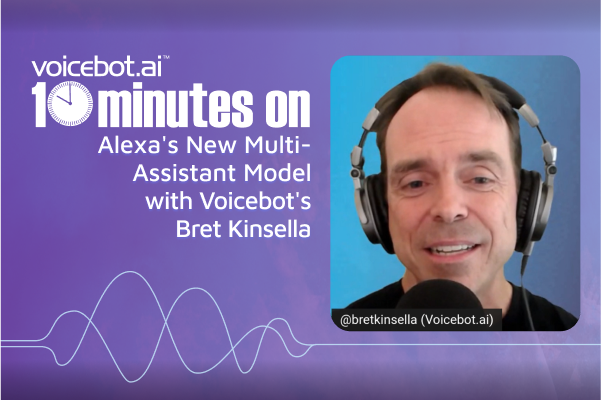10 Minutes On Alexa’s New Multi-Assistant Model with Voicebot’s Bret Kinsella (Reaction Video)
Amazon’s Alexa Live event for developers highlighted many new features and programs designed to increase Alexa skill quality, user engagement, and monetization. Alexa executives also discussed how Alexa will increasingly work alongside other voice assistants in consumer devices. There are examples of this today in Facebook’s soon-to-be-discontinued Portal and Deutsche Telekom’s Magenta. However, it has been two years since there was any movement on new simultaneous assistant implementations involving Alexa. A video shown during Alexa Live suggests that is about to change.
User Choice
Amazon launched the Voice Interoperability Initiative (VII) in 2019 alongside Baidu, Cerence, Microsoft, and 30 other companies. The announcement indicated it was “a new program to ensure voice-enabled products provide customers with choice and flexibility through multiple, interoperable voice services.” I wrote at the time:
In short, this group is focused on enabling the simultaneous presence of multiple assistants on voice-activated devices. That means multiple wake words can be used anytime to access a preferred assistant.
A key objective of VII has been the proliferation of simultaneous voice assistant access through branded wake words on a variety of devices. The original Microsoft Cortana implementation with Alexa in 2018–which was quietly dissolved last year–required that Alexa be invoked first to request access to Cortana. Facebook and Deutsche Telekom implemented the more user-friendly approach where users could say “Hey Portal,” “Hey Magenta,” or “Hey Alexa” and the requested voice assistant would respond. It appears that this is about to come to more devices as I break down in the video below.
Voice Assistant Specialization
The move to multiple simultaneous voice assistants is a recognition that no single solution will be best in class for all use cases. Indeed, no single voice assistant will be able to support all use cases. So, Sonos doesn’t have access today to weather information but can provide that easily with an Alexa integration. Sonos device users can say, “Hey Sonos” for music but learn to say “Alexa” when they want the weather or to make myriad other requests that Sonos is never likely to support. Samsung Bixby may have weather information but does not offer shopping for physical goods. Collaboration with Alexa makes sense to better meet the needs of Samsung refrigerator owners.
What we are seeing now is every company that is not Google and Apple starting to come together around interoperability through voice assistants as a new challenge to the stranglehold those companies have on direct access to consumers based on their mobile dominance. The more digital services consumer can access without having to pick up their smartphones, the less control Google and Apple have over everyday consumer experiences.
More About 10 Minutes On Interview Series
This video is part of a new series called 10 Minutes On by Voicebot.ai. The discussions and interviews focus on a single topic, are short enough to watch between Zoom meetings, and long enough to share some interesting insights and solution details. You can find more video interviews like this on Voicebot’s YouTube channel or by clicking Videos in the website’s top navigation bar.
Follow @bretkinsella Follow @voicebotai
10 Minutes On New Voice Experiences for Drivers with CARIAD Volkswagen’s Sanket Shinde
The Rise and Stall of the U.S. Smart Speaker Market – New Report









